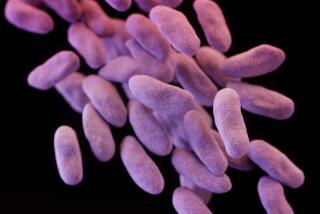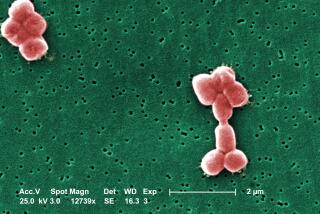New Drug May Cut Treatment Time for Tuberculosis in Half
- Share via
Human trials are beginning on a compound that promises to be the first new tuberculosis drug in four decades, one that has been shown in animal experiments to clear TB infections twice as fast as existing medications.
At least 8 million people contract TB each year and a quarter of them die, so there is a powerful demand for drugs to treat strains of the bacterium that have become resistant to existing medications. Eleven million people have both TB and HIV, which renders them more susceptible to the disease’s debilitating effects.
The new compound, developed by Dr. Koen Andries of Johnson & Johnson Pharmaceutical Research and Development in Beerse, Belgium, has been shown in mice to be effective against drug-resistant strains of Mycobacterium tuberculosis, the bacterium responsible for the devastating disease.
The compound, called R207910, works by a completely different mechanism than existing drugs, and preliminary studies in humans have shown that it is safe. Efficacy trials are underway. Andries said in a news conference that the drug could be ready for marketing in as little as five years if the trials were successful.
“If this drug is ultimately approved for humans, it could lead to a change in the treatment paradigm for tuberculosis,” he said.
The results of animal trials were published online Thursday by the journal Science. They will appear in a January issue of the magazine.
TB is currently treated with a cocktail of three drugs: rifampin, isoniazid and pyrazinamide. But it takes nine months to eradicate M. tuberculosis from the body, and many patients stop taking the drugs prematurely, both because their symptoms have disappeared and because the drugs sometimes produce serious side effects. Early termination is the primary cause of the bacterium’s growing resistance to the drugs.
There is little financial incentive for pharmaceutical companies to develop TB drugs because the vast majority of cases occur among poor people in countries that cannot pay high prices for new drugs.
The Johnson & Johnson researchers stumbled across a predecessor of the new drug while they were screening chemicals looking for new antibiotics. That chemical belonged to a class of compounds called diarylquinolines. It was not much good against most bacteria, but it did seem to be effective against Mycobacterium smegmatis, which is closely related to the TB bug.
Modifications in the original compound led to R207910, which surprised researchers with its effectiveness in mice. The drug inhibits an enzyme called ATP synthase, which plays a crucial role in providing energy for the bacterium.
“You could describe what the drug does as cutting off energy for the bacteria -- turning off the lights, you could say,” Andries said.
More important, it does it much more quickly than other drugs, eradicating all traces of bacteria from mice in two months, compared with the four months required by other drugs.
“That is why we are quite optimistic that we would be able to shorten treatment duration substantially, by about 50%,” Andries said.
“This is quite frankly an astonishing set of results,” Dr. Denis Mitchison of St. George’s Hospital Medical School in London told Science. “That’s never been done before.”
Andries and his colleagues have given different doses of the drug to nine groups of healthy humans and have observed no ill effects.
“So far, the safety of this compound is really fine,” he said.
They have begun phase 2 clinical trials in which the drug is tested for efficacy. Larger trials will probably require the cooperation of -- and perhaps additional funding from -- a group like the World Health Organization.
Dr. Christopher Dye of WHO said that the new drug represented a breakthrough, but that the organization’s possible role in any trials was yet to be determined.






